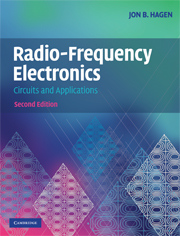Book contents
- Frontmatter
- Contents
- Preface
- 1 Introduction
- 2 Impedance matching
- 3 Linear power amplifiers
- 4 Basic filters
- 5 Frequency converters
- 6 Amplitude and frequency modulation
- 7 Radio receivers
- 8 Suppressed-carrier AM and quadrature AM (QAM)
- 9 Class-C, D, and E Power RF amplifiers
- 10 Transmission lines
- 11 Oscillators
- 12 Phase lock loops and synthesizers
- 13 Coupled-resonator bandpass filters
- 14 Transformers and baluns
- 15 Hybrid couplers
- 16 Waveguide circuits
- 17 Small-signal RF amplifiers
- 18 Demodulators and detectors
- 19 Television systems
- 20 Antennas and radio wave propagation
- 21 Radar
- 22 Digital modulation techniques
- 23 Modulation, noise, and information
- 24 Amplifier and oscillator noise analysis
- 25 The GPS Navigation system
- 26 Radio and radar astronomy
- 27 Radio spectrometry
- 28 S-parameter circuit analysis
- 29 Power supplies
- 30 RF test equipment
- Index
- References
26 - Radio and radar astronomy
Published online by Cambridge University Press: 05 June 2012
- Frontmatter
- Contents
- Preface
- 1 Introduction
- 2 Impedance matching
- 3 Linear power amplifiers
- 4 Basic filters
- 5 Frequency converters
- 6 Amplitude and frequency modulation
- 7 Radio receivers
- 8 Suppressed-carrier AM and quadrature AM (QAM)
- 9 Class-C, D, and E Power RF amplifiers
- 10 Transmission lines
- 11 Oscillators
- 12 Phase lock loops and synthesizers
- 13 Coupled-resonator bandpass filters
- 14 Transformers and baluns
- 15 Hybrid couplers
- 16 Waveguide circuits
- 17 Small-signal RF amplifiers
- 18 Demodulators and detectors
- 19 Television systems
- 20 Antennas and radio wave propagation
- 21 Radar
- 22 Digital modulation techniques
- 23 Modulation, noise, and information
- 24 Amplifier and oscillator noise analysis
- 25 The GPS Navigation system
- 26 Radio and radar astronomy
- 27 Radio spectrometry
- 28 S-parameter circuit analysis
- 29 Power supplies
- 30 RF test equipment
- Index
- References
Summary
Radio astronomy was discovered accidentally in 1931 by Karl Jansky, a physicist at Bell Telephone Laboratories. Jansky had been assigned to identify the sources of noise encountered in a newly installed transatlantic short-wave radiotelephone service. Using a directional receiving antenna on 20.5 MHz, he observed that one component of the noise, a wideband hiss, had a diurnal variation that reached a maximum intensity on average four minutes earlier each day. Jansky knew that the stars advance in just this way (in siderial time) and deduced that the source of the hiss must be outside the solar system. His observations showed that this “cosmic noise” came from the galactic plane and was strongest from the direction of the galactic center (in the constellation Sagittarius).
After Jansky, the second pioneer of radio astronomy was a radio engineer, Grote Reber, who in 1937, built a 9-m (30-ft) parabolic reflector beside his house in Wheaton, Illinois. This was maybe the first modern dish antenna. Reber began his observations using a receiver at 3 GHz, which pushed the high-frequency state of the art, because he assumed that cosmic radio noise was the low-frequency tail of the thermally generated radiation spectrum from white-hot stars. The intensity of this radiation would increase as the square of the frequency, so using the highest practical frequency would make detection easier and would also make his antenna more directive.
- Type
- Chapter
- Information
- Radio-Frequency ElectronicsCircuits and Applications, pp. 364 - 374Publisher: Cambridge University PressPrint publication year: 2009



